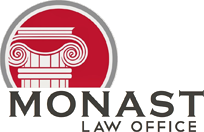
As one of the most important joints in your body, your shoulder’s range of motion is seriously compromised when you experience a labrum tear. An injury like this impacts your livelihood and your daily life. When something like this happens on the job, fighting for workers’ compensation benefits shouldn’t add to your suffering.
At Monast Law Office, we help employees in Columbus and throughout Ohio document their injuries properly and uphold their rights to the compensation they need to recover. Let's look at what you need to know about workers' compensation claims for labrum tears.
Table of Contents
Understanding Your Shoulder Labrum Injury
First, a quick anatomy lesson. Your shoulder is a ball-and-socket joint where the head of your upper arm bone, or humerus, fits into a shallow socket, the glenoid, in your shoulder blade. The labrum is a ring of strong fibrous tissue surrounding the glenoid, deepening the socket and helping stabilize the joint. Think of it like a rubber gasket that helps keep your shoulder in place while allowing smooth motion.
This tissue is crucial for overhead movements, lifting, and the dynamic range of motion your shoulder needs for work activities. When the labrum tears, you lose this vital stability, often resulting in pain, weakness, and a feeling that your shoulder might slip out of place during specific movements.
People in many professions experience this injury because of:
- Repetitive overhead motions from stocking shelves, construction, or manufacturing jobs.
- Sudden trauma from falls or direct impact on the shoulder.
- Heavy lifting, especially with poor ergonomics or inadequate assistance.
- Pulling or pushing heavy objects.
- Catching yourself during a slip or fall with an outstretched arm.
Recovery Timeline for a Shoulder Labrum Tear
You can’t simply shrug off this injury—you need adequate time off and support from workers’ compensation.
Your rate of recovery depends on several factors. Some people may return to modified work or light duty for minor tears treated without surgery after 4–6 weeks of conservative treatment. However, many work-related labrum tears require surgical repair, significantly affecting your average settlement.
Initial Phase (0–6 weeks)
Most workers need to wear a sling and focus on gentle movements prescribed by their physical therapist. You'll likely be unable to work during this time, especially if your job involves lifting or overhead movements.
Intermediate Phase (6–12 weeks)
Physical therapy intensifies as you regain range of motion and begin strengthening exercises. Some workers may return to modified or light duty with strict restrictions on lifting and overhead movements.
Advanced Phase (3–6 months)
Continued rehabilitation focuses on restoring full strength and function. At this point, many workers return to regular duties, though some overhead restrictions may remain.
Full Recovery (6–12 months)
Complete healing and return to all work activities, including heavy lifting and repetitive overhead movements. Some workers may need to adjust their technique or use assistive devices to prevent re-injury.
Key Elements of a Successful Labrum Tear Claim
It’s common for an initial workers’ comp evaluation to minimize the extent of your shoulder injury. That happened to our client, Josh, who tore the bicep and tendons of his rotator cuff, as well as the cartilage around his shoulder joint. His claim only allowed for a strain, so physical therapy and other treatments didn’t help. Finally, 18 months later, he was granted the opportunity for covered surgery—but he had to go through several Ohio Bureau of Workers’ Compensation (BWC) hearings first.
To improve your chances of prompt approval for a torn labrum workers’ comp settlement, here’s what we need to do:
- Prove a clear connection to work activities. Your injury report is the critical starting point for filing for workers’ compensation. It should have a complete description of the job duties that contributed to the labrum tear, a history of similar movements or tasks in your role, and even witnesses to the incident.
- Provide comprehensive medical documentation. This includes records from your initial injury report, diagnostic imaging showing the tear, treatment plans and progress notes, and details of work restrictions.
- Outline medical history. While preexisting conditions generally aren’t covered, there are certain situations in which workers’ compensation will provide benefits to address them. For example, if you have a health issue that a workplace-related labrum tear aggravates or needs to be discussed before this injury is resolved.
Now, don’t be surprised if your employer or the BWC examines everything about your shoulder labrum tear claim to the letter. They’ll wonder if it’s an age-related, not a work-related, injury. They’ll analyze the timing of it or your course of treatment. Like in Josh’s case, they might also question the need for surgery.
But living with a shoulder labrum tear means facing daily challenges, from sharp pain when you reach for a coffee mug to lying awake at night trying to find a comfortable position. While you focus on healing, let our team handle your claim. We understand what medical evidence you need and how to counter attempts to minimize your injury so you receive proper compensation.

